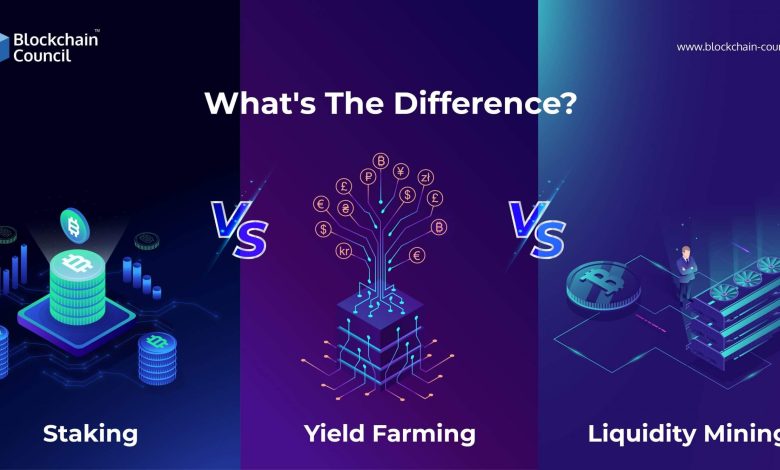NFT Staking and Yield Farming Explained

- Understanding NFT Staking: A Beginner’s Guide
- The Basics of NFT Staking and How It Works
- Yield Farming with NFTs: What You Need to Know
- Maximizing Returns: Strategies for NFT Staking
- The Risks and Rewards of NFT Staking and Yield Farming
- Exploring the Future of NFT Staking in the Crypto Space
Understanding NFT Staking: A Beginner’s Guide
Understanding NFT staking can be a lucrative way to earn passive income in the world of cryptocurrency. NFT staking involves locking up your non-fungible tokens (NFTs) in a smart contract for a set period of time in exchange for rewards. These rewards can come in the form of additional NFTs, tokens, or other benefits.
When you stake your NFTs, you are essentially contributing to the security and stability of the blockchain network. By participating in staking, you help validate transactions and maintain the integrity of the network. In return for your contribution, you are rewarded with a share of the transaction fees or other incentives.
Before you start staking your NFTs, it’s important to do your research and choose a reputable platform or project to stake with. Make sure to read the terms and conditions carefully and understand the risks involved. Additionally, consider diversifying your staking portfolio to minimize risk and maximize potential rewards.
The Basics of NFT Staking and How It Works
NFT staking is a process where NFT holders can lock up their non-fungible tokens in a smart contract for a specified period to earn rewards. This allows NFT owners to generate passive income while supporting the network. The concept of staking NFTs is similar to staking cryptocurrencies, where users lock up their tokens to secure the blockchain and validate transactions.
When an NFT holder stakes their tokens, they are essentially contributing to the liquidity of the platform and helping to maintain the network’s security. In return for staking their NFTs, users receive rewards in the form of additional tokens or other incentives. These rewards can vary depending on the platform and the duration of the staking period.
Staking NFTs can also provide users with voting rights and governance over the platform. This means that NFT holders have a say in the decision-making process and can help shape the future of the network. By actively participating in staking, users can not only earn rewards but also contribute to the growth and development of the ecosystem.
Yield Farming with NFTs: What You Need to Know
Yield farming with NFTs is a relatively new concept in the world of decentralized finance (DeFi). It involves using non-fungible tokens (NFTs) as a way to generate passive income through various DeFi protocols. By staking NFTs, users can earn rewards in the form of additional tokens or other benefits.
One of the key benefits of yield farming with NFTs is the ability to earn passive income without actively trading or investing in the volatile cryptocurrency markets. Instead, users can simply stake their NFTs and let the smart contracts do the work for them. This can be especially appealing to those who are new to DeFi or who prefer a more hands-off approach to investing.
When participating in yield farming with NFTs, it is important to do your research and choose reputable DeFi protocols to minimize the risk of loss. Additionally, be sure to consider factors such as the APY (annual percentage yield) offered, the lock-up period for staking your NFTs, and any potential fees associated with the process.
Maximizing Returns: Strategies for NFT Staking
When it comes to maximizing returns through NFT staking, there are several strategies that can be employed to optimize your yield farming efforts. By carefully considering these approaches, you can make the most of your NFT assets and generate higher profits.
- Choose the Right Platform: Selecting the appropriate staking platform is crucial for maximizing returns. Look for platforms that offer competitive APY rates and have a solid reputation in the market.
- Diversify Your Portfolio: To reduce risk and increase potential rewards, consider staking a diverse range of NFT assets. This can help you capitalize on various market trends and opportunities.
- Monitor Market Trends: Stay informed about the latest developments in the NFT space to make informed decisions about when to stake or unstake your assets. Keeping an eye on market trends can help you maximize your returns.
- Reinvest Rewards: Instead of cashing out your staking rewards immediately, consider reinvesting them back into your staking portfolio. This can compound your earnings over time and boost your overall returns.
- Stay Updated on Fees: Be aware of any fees associated with NFT staking, such as gas fees or platform charges. By minimizing these costs, you can maximize your net returns from staking.
By following these strategies and staying proactive in your approach to NFT staking, you can optimize your yield farming efforts and achieve higher returns on your investment. Remember to stay informed, diversify your portfolio, and make strategic decisions to make the most of your NFT assets.
The Risks and Rewards of NFT Staking and Yield Farming
When it comes to NFT staking and yield farming, there are both risks and rewards that investors need to consider before getting involved in these activities. It is important to understand the potential benefits and drawbacks of staking and yield farming in the NFT space.
One of the main risks of NFT staking is the volatility of the market. NFT prices can fluctuate wildly, which means that investors could potentially lose money if the value of their staked assets decreases. Additionally, there is always the risk of smart contract bugs or vulnerabilities that could result in the loss of funds.
On the other hand, there are also rewards to be had from NFT staking and yield farming. By staking NFTs, investors can earn rewards in the form of additional tokens or NFTs. This can be a great way to generate passive income and increase the overall value of their NFT portfolio.
Yield farming, on the other hand, involves providing liquidity to decentralized finance (DeFi) protocols in exchange for rewards. While this can be a lucrative way to earn additional tokens, it also comes with its own set of risks. Impermanent loss, smart contract risks, and the potential for rug pulls are all factors that investors need to consider before participating in yield farming.
Ultimately, the decision to stake NFTs or participate in yield farming should be made carefully, weighing the potential risks and rewards. It is important for investors to do their own research and understand the intricacies of these processes before diving in headfirst.
Exploring the Future of NFT Staking in the Crypto Space
As the world of cryptocurrency continues to evolve, the future of NFT staking is a topic that is gaining more and more attention. NFT staking allows users to earn rewards by locking up their non-fungible tokens in smart contracts. This process helps to secure the network and incentivizes users to hold onto their NFTs for longer periods of time.
One of the key benefits of NFT staking is the ability to earn passive income on your digital assets. By staking your NFTs, you can earn a yield in the form of additional tokens or other rewards. This can be a great way to make your NFT collection work for you, even when you’re not actively buying or selling.
Another exciting development in the world of NFT staking is the rise of yield farming. Yield farming allows users to earn even higher returns on their staked NFTs by participating in various liquidity pools and other DeFi protocols. This can be a more complex process than traditional staking, but the potential rewards can be well worth the effort.
Overall, the future of NFT staking in the crypto space looks bright. As more users discover the benefits of staking their NFTs, we can expect to see even more innovative staking mechanisms and opportunities for earning rewards. Whether you’re a seasoned crypto investor or just getting started, NFT staking is definitely a trend to keep an eye on in the coming months and years.




